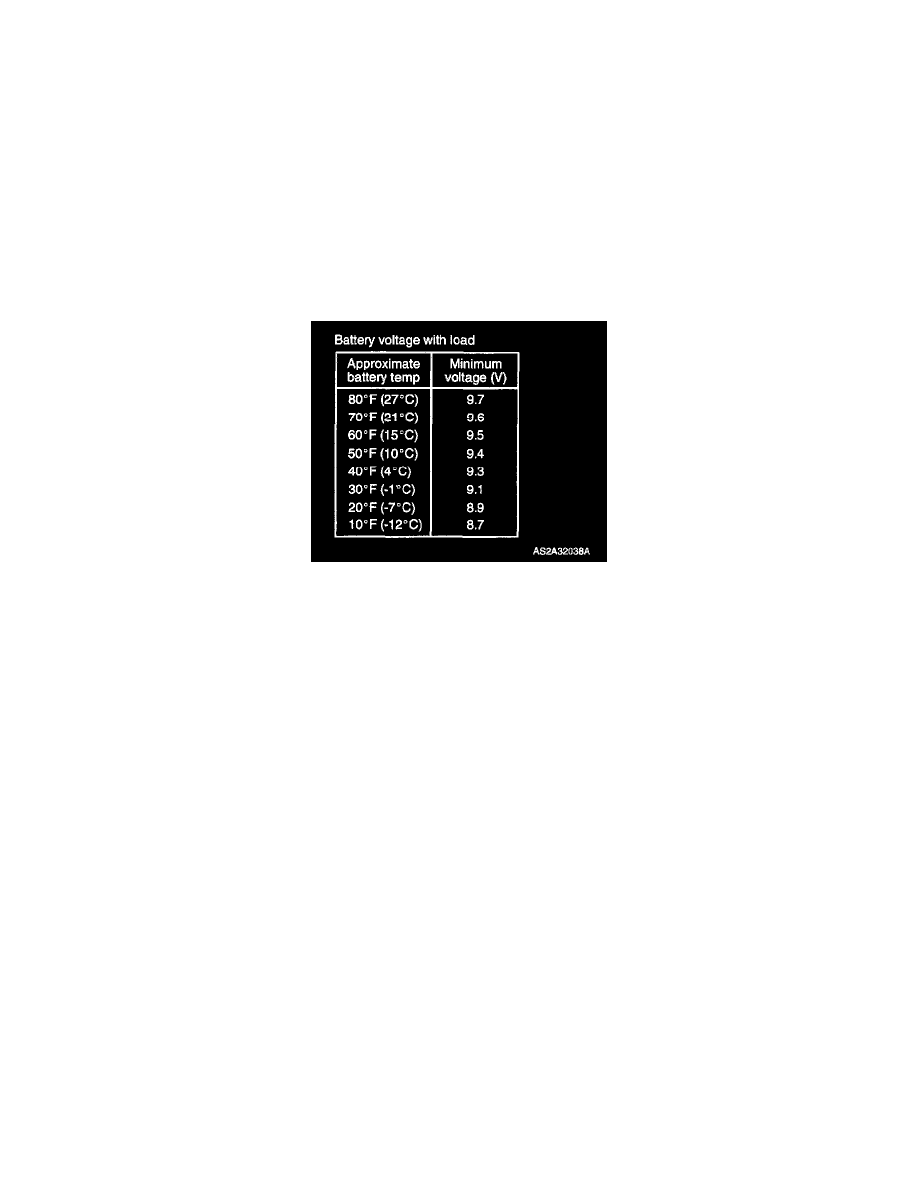Rio Cinco L4-1.6L DOHC 16V (2003)

1. Before measuring the open-circuit voltage, the surface charge must be removed from the battery. Turn on the headlights for fifteen seconds, then
allow up to five minutes for the battery voltage to stabilize.
2. Disconnect and isolate both battery cables, negative cable first.
3. Using a DVOM(Digital Voltage and Ohm Meter) connected to the battery post, measure the open-circuit voltage. Refer to the Open-Circuit
Voltage table. This voltage will indicate the battery state-of-charge, but will not reveal its cranking capacity. If the open-circuit voltage reading is
12.4 V or greater, perform the load test.
BATTERY LOAD TEST
1. Disconnect and isolate both battery cables, negative cable first. Make sure the battery top and posts are clean.
2. Connect a suitable VAT Tester to the battery posts. Check the open-circuit (no load) of the battery. Open-circuit voltage must be 12.4 V or greater.
3. Apply a 300 Amp load to the battery for fifteen seconds to remove the surface charge from the battery, then allow the battery to stabilize for five
minutes.
4. Apply a load equal to 50% of the CCA rating of the battery. After approximately fifteen seconds, check the loaded voltage reading, then remove
the load.
5. The voltage drop will vary with the battery temperature at the time of the load test.
BATTERY IGNITION OFF DRAW TEST
The battery draw test refers to power being drained from the battery with the ignition switch in the OFF position. A normal electrical system will draw
from five to twenty-five milliamps (0.005 to 0.025 ampere) with the ignition OFF and all non-ignition controlled circuits working properly. The 0.025
ampere is needed to enable the memory functions of the vehicle to function.
1. Verify that all electrical accessories are OFF. Turn off all lamps, remove the ignition key and close all doors.
2. Disconnect the negative battery cable.
3. Set a DVOM (Digital Voltage and Ohm Meter) to its highest amperage scale and connect the DVOM between the disconnected negative battery
cable and the negative battery post.
4. If the amperage reading is higher that 0.025 ampere, remove each fuse until the amperage reading becomes within specifications, this will isolate
each circuit and identify the source of the draw. If the amperage reading remains high after disconnecting each fuse, unplug the connector from the
generator. If the amperage reading becomes within specifications, check the charging system.
5. After appropriate repairs have been made, retest the system.
VOLTAGE DROP TEST
The voltage drop test will determine if there is excessive resistance in the battery terminal connections or the battery cables. When performing these
tests, remember that the voltage drop is giving an indication of the resistance between the two points at which the DVOM probes are attached. For
example, when testing the resistance of the battery positive cable, connect one of the DVOM leads to the positive battery cable clamp and the the other
cable connector at the starter solenoid. If you probe the positive battery terminal post and the cable connector at the starter solenoid, you are actually
reading the combined voltage drop in the positive battery cable clamp-to-terminal post connection and the positive battery cable.
1. Connect the positive lead of the DVOM to the negative battery terminal post.
2. Connect the negative lead of the DVOM to the negative battery terminal cable clamp.
3. Turn the ignition switch to the start meter and observe the DVOM. If voltage is detected, correct the poor contact between the cable clamp and the
terminal post.
4. Connect the positive lead of the DVOM to the positive battery terminal post.
5. Connect the negative lead of the DVOM to the positive battery terminal cable clamp.
6. Turn the ignition switch to START and observe the DVOM. If voltage is detected, correct the poor contact between the cable clamp and the
terminal post.
